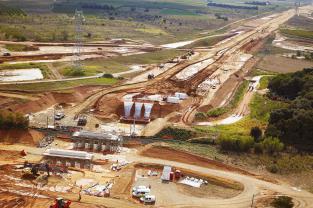TERRASOL has been working on the Nîmes – Montpellier railway bypass since 2010, first of all on the occasion of the response to the proposal by the OC’VIA Construction group (BOUYGUES), followed by the project (preliminary and detailed) design studies. For these studies, TERRASOL, alongside Systra, had defined the necessary geotechnical testing programmes (phases BC1 to BC4), then carried out the geotechnical design studies for the standard engineering structures of the “Gard” works package (from Vidourle to Manduel), and lastly took part in the studies for the two special engineering structures (Lez Viaduct and Manduel cutting). A total of nearly a hundred structures had been studied by spring 2013.
As part of the detailed geotechnical works design, the OC’VIA Construction group subsequently contracted TERRASOL to update the geotechnical design studies for the engineering structures of works package “Hérault” and “Gard”. This contract covered the incorporation of the latest available data from the additional soil-testing campaign (series BC5 to BC8, focusing on the karst issues among other aspects) and, if possible, optimisation of the geotechnical parameters used for the foundations design. Worth mentioning in particular is the grade separation RL015-2, carrying the future track V2 of the Lattes connection over the existing Tarascon-Sète line. This structure is part of the “Hérault” works package and is located in a difficult geological context: the limestone massif, subcropping in the South zone of the structure, plunges abruptly and to great depth in the North zone of the structure, below the quaternary and tertiary formations of the coastal plain.
In addition, karstification processes are affecting this limestone substratum. The foundation techniques consequently chosen for the structure combine karst treatment grouting, shallow foundations, piles anchored into the rock and floating piles in the tertiary formations. This update of the geotechnical studies for more than 160 civil engineering structures was carried out from October 2013 to November 2014 and was concurrent with the studies of the hydraulic structures.
In parallel, TERRASOL is working actively on site. In the spring of 2014, an engineer worked in the geotechnical unit of the technical department to ensure coordination between studies and works, and for monitoring the completion of the foundations works. Since May 2014, an engineer has been seconded to the Works Management team, with duties including inspection operations. Among all the geotechnical issues encountered, three topics are the focus of most of the activity of the geotechnical services:
- Problems related to the karsts and to their backfilling; 3 separate limestone formations are undergoing in-depth studies and treatments.
- Monitoring and checking of the foundations of the engineering structures, and in particular the piles: a real challenge in view of the number to be completed (more than 1200).
- Monitoring of the challenging jet-grouting operations under the existing SNCF (French railways) tracks for the Manduel cutting.
Terrasol’s achievements:
- 2010-2015Preliminary and project design of standard and non-standard civil engineering structures (160 standard structures)
- Monitoring of geotechnical surveys
- Detailed design of the standard civil engineering structures
- Studies of hydraulic structures
- External control of technical blocks
- Geotechnical project management
 Agent Access
Agent Access 




